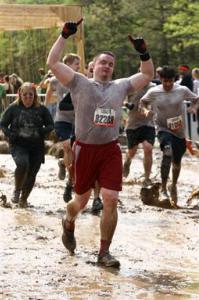I participated in the Pennsylvania #2 Tough Mudder event on Saturday, May 12 2012 with a few of my closest friends. Other than a few pictures, videos, and notes on the Tough Mudder website I really didn’t know what to expect. I knew it was going to be a physically demanding challenge the likes of which I had never experienced, and that’s exactly what it was.
- Advertisement -
This particular Tough Mudder was 12.5 miles long with 25 obstacles along the way. Most of the running was on trails, through the woods, up hills, down hills, through shallow creeks, and mud. Rarely was I running on a flat, even surface. Several obstacles contained ice-cold water pits, mud, rocks, barbed wire, and electric shocks. A few obstacles required teamwork while others I had to rely on my own balance, upper body strength and/or grip. With my experience fresh in mind, I hope to help you train for your Tough Mudder event and give you a heads up on what to wear on Mudder day.
HOW TO TRAIN FOR TOUGH MUDDER
- Advertisement -
Tough Mudder will punish you, no matter your shape, size, or current level of fitness. As such, we encourage all Mudders to increase their physical training in preparation for the event. That said, completing a Mudder is as much about mental toughness, grit, and camaraderie (and having a great time) as anything exclusively physical. In terms of what you are looking at: each Tough Mudder course will have 10-12 miles of hills, mud, water, ropes, walls, electric shocks, and fire designed to push you to your limit.
Don’t think you have to look like Rambo to complete a Tough Mudder. On Mudder day you will see people of all shapes and sizes tackling the course. In order to complete the course and each obstacle, though, you’ll need to be in decent cardiovascular shape and develop some sort of upper body strength.
- Advertisement -
RUNNING
Tough Mudder recommends being able to run at least 5 miles at once without passing out. If you achieve this level of cardiovascular fitness, you will be fine come Mudder day. I recommend beginning your training at least 3 months in advance and starting slow. You don’t want to peak at the wrong time. Build your way up to running 5 miles a day 4 to 5 days a week and you’ll be in good shape.
3 months away- 3 miles 3 to 5 days a week
2 months away-4 miles 4 to 5 days a week
1 month away-5 miles 4 to 6 days a week
Be sure to mix in some out-door running with your training regimen. A treadmill can’t possibly simulate the type of running you’ll be doing on Mudder day. Running trails is ideal, but make do with what is at your disposal. If you don’t have access to a trail nearby, be sure to take a few runs through the nearest park in preparation for the event.
STRENGTH TRAINING
Developing some sort of upper body strength is essential if you plan on completing every obstacle at Tough Mudder. However, even if you get yourself to the point where you can do 30 chin-ups in a row, there is no guarantee you will make it across the monkey bars or rings on Mudder day. There are obstacles that will drain your strength, your equipment may fail you, many things can happen. But don’t get discouraged, falling in the water pits is half the fun.
With that said, there is no better exercise to prepare you for Tough Mudder than chin-ups. The muscles used during and the movement of chin-ups most closely replicates the event itself. You can purchase a chin-up bar on eBay for under $30. It’s worth the investment. Again, start off slow, and work your way up to as many chin-ups you can possibly do at one time. Don’t strain yourself, just consistently build up until you’ve reached your max.
In addition to chin-ups I recommend doing a complete upper body workout several days a week. If you belong to a gym, a training regimen of bicep curls, bench press, shoulder press, triceps exercises and back exercises will help you get ready for the event. If you do not belong to a gym you can do push ups, squat thrusts, dips (using a bench or chair), and calisthenics to prepare you for Mudder day. If you have no clue what you are doing when it comes to exercise, go to YouTube and search “no equipment home workout” for some tips. Weight training 3-5 days a week is essential for preparing yourself for Tough Mudder.
WHAT TO WEAR FOR TOUGH MUDDER
There are 3 things that are inevitable on Mudder day:
1. You’re going to sweat
2. You’re going to get wet
3. You’re going to get dirty
Keep this in mind when selecting your equipment for Tough Mudder. The more absorbent material you have on, the heavier you’re going to get while running. Form-fitting, sweat wicking materials are best. While gloves aren’t essential, they do come in handy by preventing splinters when climbing over wooden walls and protecting your hands from blisters on certain obstacles. I wore full-fingered gloves which I blame entirely for my slipping on the monkey bars, as once they were wet and full of mud provided absolutely no grip. Fingerless gloves are probably the way to go, but if I ever do another Tough Mudder I’ll be taking off my gloves for the gripping obstacles entirely.
TOPS
Form fitting, sweat wicking shirts are best for Tough Mudder. Under Armour, Nike Dri-FIT, Adidas CLIMACOOL are all highly recommended. While you don’t necessarily want to wear a compression shirt, something that is tighter on your body will work to your advantage. I cannot speak highly enough of the Nike Pro Combat Core Fitted shirts. Even after jumping into ice-cold water and crawling on my hands and knees through mud I did not feel weighed down by my shirt.
Get a shirt appropriate for the weather you will be doing the Tough Mudder in. If it’s going to be cold, go with the long sleeve fitted shirt. If it’s hot, go for the short sleeve or even the sleeveless. Be smart and use your best judgement. One shirt is enough, you don’t need layers.
Pro tip: Tuck your shirt in on Mudder day. The tucked in part will remain relatively clean after you crawl through mud and will be useful to wipe the dirt and grime out of your eye.
BOTTOMS
I can’t stress enough how important compression shorts or leggings are. Not only do they help with your muscles, they prevent a runners worst enemy: chafing. Under Armour makes the best compression shorts/leggings hands-down. If I could go back in time, I would have worn the Under Armour Heat Gear leggings instead of the Under Armour 7″ compression shorts. While you’re crawling on your hands and knees through mud, you’re also scraping those knees on the hundreds of rocks in said mud. A thin layer over my knees would have saved me from the painful sting of a soapy shower after the event.
As for shorts to go over your compression shorts/leggings, I again recommend Nike Dri-FIT or Adidas CLIMACOOL running or soccer shorts. Lightweight, sweat wicking shorts are the way to go on Mudder day. You don’t need to wear a bathing suit or water proof shorts. Just keep it light and simple and you’ll be fine.
SHOES
The shoes you wear to Tough Mudder will be absolutely destroyed by the end of the event. You’re going to be running through mud, diving into water, and then running through more mud. Be prepared to throw them out after the event. You don’t have to get special trail running shoes for the Mudder, any pair of running shoes will be fine. As for shoes I don’t recommend, I advise against Vibram Fivefingers Barefoot Sports Shoes and Reebok ZigTech. The Vibram shoes might sound like a good idea until you start running on jagged rocks and rough terrain. As for the ZigTech running shoes, they’re great to train in but the nooks and crevices of the zig-zag outsole will most certainly fill up with mud and weigh you down.
Whatever shoes you wear, just be sure to tie them tight and double knot them. The last thing you want is to get a shoe stuck in the mud and have it fall off of your foot. I saw some people wrapping tape around their shoes and ankles which looked stupid in my opinion. Just lace your shoes up tight, double knot and you’ll be fine.
GEAR
Fingerless gloves are highly recommended. I wore full-fingered gloves and wish I had gone with the fingerless type instead. Just like everything else on your body, your gloves are going to get wet and dirty, and the grips on them may fail you when it comes to the monkey bars or rings. Whatever gloves you choose, I recommend taking them off for the monkey bars and rings as you’ll be better off with your bare hands on those obstacles. The main purpose of gloves is to protect your hands from splinters when climbing walls and preventing blisters when climbing ropes and cargo nets.
An armband will also come in handy when you want to wipe some mud out of your eyes. Sure, the armband itself will get wet and muddy, but just flip it over and you’ll have a relatively clean piece of material to get the muck out of your face.
POST MUDDER
Be sure to take full advantage of the freebies they hand out at the finish line. Protein powder, Cliff Bars, bananas, fruit snacks, and of course your celebratory Dos XX beer. Make sure you grab a Tough Mudder headband and T-shirt as your trophy for completing the course, and make use of the shiny metal looking thermal blanket as a seat cover to protect your car seat for the drive home. You’re going to feel exhausted after the Mudder, but it’s nothing compared to how your muscles will feel the next 2 to 3 days afterwards. Rest up and pop an Advil or two.
Tough Mudder is about completing a physically demanding obstacle course with friends and other people looking to challenge themselves. Train hard, help your fellow Mudders on the course and have fun. It doesn’t matter how long it takes you to complete the Tough Mudder as long as you don’t quit. Good luck on your Tough Mudder, it truly is an experience of a lifetime.











